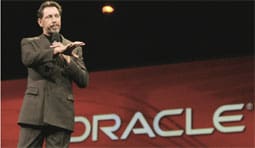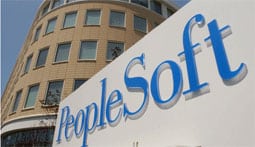Customers and competitors may be among the biggest winners after Oracle seals the deal to acquire PeopleSoft.

It took more than 18 months to complete and will go down as one of the most acrimonious mergers in recent history, but Larry Ellisons Oracle finally sealed a deal with PeopleSoft that will see the combined group become the worlds second-biggest business software maker. In the process, however, both companies customers and employees have become increasingly nervous, while many analysts had predicted that the only real winner would be PeopleSoft and Oracles much bigger rival, SAP.
Certainly, PeopleSofts 11,000 employees had good reason to worry. Only a week after Oracle sealed its $10.3 billion takeover, it announced that more than 5,000 people-mostly PeopleSoft employees-would be laid off. But now that the dust stirred up around the deal is starting to settle, analysts dont expect the takeover-or the layoffs that represent about 9% of the new companys combined workforce of 55,000-to hurt the nearly 23,000 corporate customers of either software manufacturer.
“The layoffs were expected, and most of that is happening where you would expect-in areas such as marketing and administration-when two companies merge,” says Mike Dominy, director of enterprise services at The Yankee Group in Boston. “I dont think its going to affect customers from a support position. And I dont think it will affect the creativity of the company.”
Although they had not yet seen the details of the layoffs, analysts knew the purge was coming, and many had expected the total to tally closer to the 6,000 that Oracle envisioned when it first set its sights on PeopleSoft nearly two years ago.
“The vast majority of layoffs are going to come at PeopleSoft,” adds Paul Hamerman, vice president of enterprise applications at Forrester Research in Cambridge, Massachusetts.
The final closing of the deal early last month ended an aggressive and tenacious 19-month corporate battle led by Lawrence J. Ellison, the chief executive officer at Oracle, which is based in Redmond Shores, California. PeopleSoft, based in nearby Pleasanton, California, fought the takeover in a battle marked by two court struggles and public vows by Ellison to shut down PeopleSoft and discontinue its products.
Ellison has since backed off from that belligerent stance, and the company has promised to provide PeopleSoft customers with the technical support they need for nearly a decade, through 2013. And analysts dont expect Oracle to skimp on their support services for PeopleSoft corporate customers.
“From a technical perspective, a merger can always be difficult,” says David Schatsky, a senior vice president at Jupiter Research in New York City. “But there could be big consequences for Oracle if they botched their support.”
One negative outcome would simply be that the information technology executives that use PeopleSoft for their sophisticated software applications could abandon ship and head to third-party vendors for their service agreements. And competing software vendors will try to take advantage of the business opportunities created by any ill-will by trying to siphon off PeopleSoft customers. “Microsoft is already offering discounts to them, and I expect something similar from SAP,” Schatsky adds. SAP has its US headquarters in Palo Alto, California, and remains the worlds largest manufacturer of business software.
Hamerman says Oracle will want to keep as much as possible of the $1.5 billion in revenue that maintenance contracts have contributed to the PeopleSoft bottom line.
“They also will want to sell them [PeopleSoft customers] other Oracle products and support a profitable business,” adds Hamerman. “I think they will provide a good level of service.”
|
Some believe the merger will provide benefits for the customers of the two merged software entities as it fattens Oracles bottom line. Over the short-term, corporate customers will gain improved access to Oracles strength in database applications and PeopleSofts strength in software applications, such as those used by human resources departments and state and local governments. “This will provide an additional source of revenue for Oracle,” adds Dominy of The Yankee Group. “Theres a lot of potential for Oracle.” Over the longer term, Oracle customers will benefit from the talents and knowledge of the PeopleSoft workforce. “The intellectual capital of PeopleSoft will naturally be incorporated into the Oracle applications,” says Dominy.
But analysts agree that most users wont be making any major decisions for the next two years-the purchase of an enterprise resource planning (ERP) system can take up to a year-and will take advantage of the technical support Oracle has promised to deliver.
Analysts expect, for example, that Oracle will invest more in its E-Business Suite program and slowly incorporate the best PeopleSoft features. Customers in both camps will no doubt shift toward new products like this over the next three to five years.
Gartner predicts that the acquisition of PeopleSoft will also benefit Oracles growth in the Asia-Pacific region. Although the merger will not make Oracle the dominant force in Asia-Pacific (SAP had a 28.1% share of the Asian ERP market in 2003 based on license fees, compared to Oracles 19.1%), Gartner analysts say if Oracle can merge its application support groups effectively with PeopleSofts, customers of both companies will gain resources. This is aided by the fact that Oracle had already appointed former Australian general manager Brian Mitchell to manage mergers in the Asian region, which Gartner says should mean a “speedy consolidation” of the two companies Asia-Pacific managers.
Additional reporting by Anita Hawser




